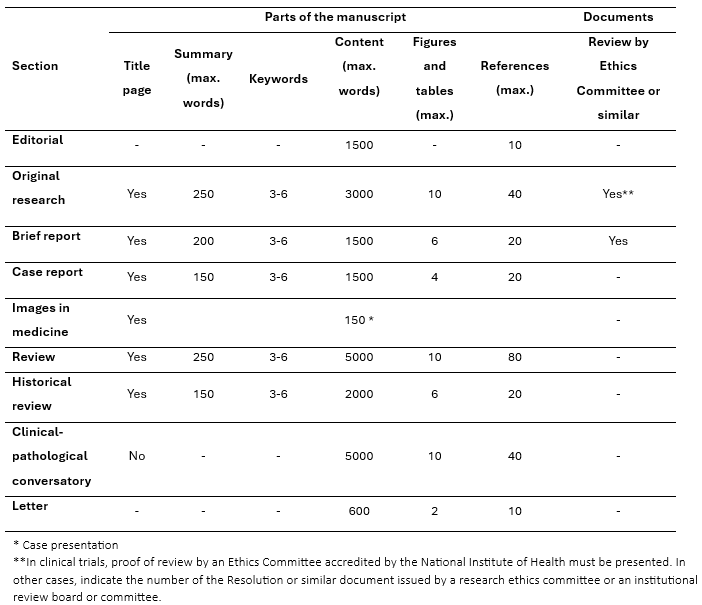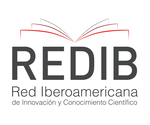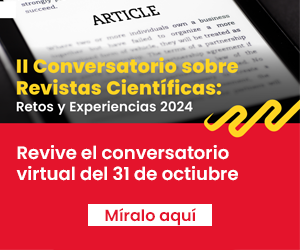Submissions
Submission Preparation Checklist
As part of the submission process, authors are required to check off their submission's compliance with all of the following items, and submissions may be returned to authors that do not adhere to these guidelines.- The article without including the names of the authors and their institutional affiliation has been evaluated by a program to detect similarities and its similarity index is less than 15%
- Along with the manuscript (without authors and without institutional affiliation), the title page and the annexes required by the RMH are sent, as appropriate (letter of presentation of the article, sworn declaration, declaration of financing and conflict of interest, ICMJE disclosure form, or authorization for publication of the case report)
- Submission file is in text document file format (MS Word or similar). The manuscript is written in Spanish, Portuguese, or English, in ISOA4 format (212x297 mm), Times New Roman font, font size 12 picas, double spaced, with 25 mm margins. Pages numbered at the bottom right.
- The manuscript complies with the structure established by the RMH, the tables, graphs and figures with their titles and notes ordered sequentially are located after references. The figures sent are high resolution.
- A statement that the research was reviewed and approved by an independent local, regional, or national review body; for example, a research ethics committee or an institutional review board or committee (Resolution Number or similar document), is included in the manuscript. In the case of clinical trials, proof of review by the Research Ethics Committee is attached.
- Researchers indicated as authors have participated in the planning, research, writing and approval of the manuscript, and are also responsible for the content of the publication.
Author Guidelines
INFORMATION AND INSTRUCTIONS FOR AUTHORS
The Revista Médica Herediana (RMH) is a scientific publication of School of Medicine of the Universidad Peruana Cayetano Heredia, whose mission is the dissemination of original and unpublished works that contribute to the knowledge of biomedical sciences, especially clinical medicine. of Public Health and medical education, carried out at the national and international level. It is refereed by peers, quarterly and open access. Receive articles in Spanish, English and Portuguese.
Before starting the preparation of the manuscript, carefully read the Editorial Policy and the research and publication ethics policies established by the journal and verify compliance. Also, review aspects of the RMH editorial process.
Authors should indicate whether they used Artificial Intelligence (AI)-assisted technologies such as Large Language Models (LLM), chatbots, or image creators in the production of the submitted work. Authors who use such technologies should describe how they used them in both the cover letter and the submitted work, in the relevant section.
The Revista Médica Herediana does not accept the inclusion or withdrawal of authors after the editorial process of the manuscripts has begun. Likewise, it does not accept the modification of institutional affiliation or degrees or titles.
TYPES OF MANUSCRIPTS
The Revista Médica Herediana publishes the following types of articles:
- Editorial (On request)
- Original research article: unpublished work that describes or shows results of scientific research in the biomedical area that provides new information on a specific topic and contributes to scientific knowledge.
- Brief report: short reports of partial or results of a short descriptive research, progress, or other observations of scientific interest.
- Case reports: are presentations of cases of one or several patients with some diagnostic or therapeutic particularity important to communicate, with a brief review of similar publications.
- Images in Medicine: it is a work that shows images of the clinical examination or of some diagnostic imaging test of importance for medical knowledge. It is accompanied by a brief description of the case and the image.
- Historical review: it is a manuscript that describes some character or event that occurred and their contribution to the development of biomedical sciences or health policies.
- Review: presents the current state of knowledge on a topic or disease; It can be of two types:
- requested directly by the Editorial Board from experts on the subject,
- presented by professionals interested in a particular topic. In this case, the article will be reviewed by specialists on the subject. They are published in the Special Contribution section.
- Clinical-pathological conversatory (By section editor): the case of a patient and the discussion of the differential diagnosis are presented with comments from the specialists who participated in the evaluation of the patient. Findings from laboratory, imaging, and pathologic examinations are reviewed.
- Letters: readers can send comments on an article published in the journal or on the topic of a published article or of biomedical interest. The decision on the publication of letters received is at the discretion of the Editorial Board.
PRESENTATION AND SUBMISSION OF THE MANUSCRIPT
The manuscript (without the names of the authors, the institution where the study was carried out, the corresponding author, and the authorship contribution) must be sent together with the following documents:
- Title page. The title page is presented in a separate file. It must contain: Article title, short title, Author information, institution where the study was carried out, and the contribution of authorship (according to the criteria of the International Committee of Medical Journal Editors). Also, corresponding author information, word count, and number of tables, graphs, and figures.
- Article presentation letter (according to established format). Addressed to the Editor-in-Chief of the Revista Médica Herediana, signed by one of the authors, requesting an evaluation to be considered for publication. The letter must include the title of the work, the full name of the authors and type of article. In addition, please indicate whether the manuscript is part of or based on a degree or undergraduate thesis and whether artificial intelligence (AI)-based tools were used in its preparation.
- Affidavit (according to established format). It is declared that the article presented is the intellectual property of the authors, which has not been published or presented for evaluation in another journal, transferring the editing, publication and dissemination rights to the Revista Médica Herediana in case the manuscript is accepted for publication. Likewise, they declare that they comply with the Journal's authorship recognition policy and commit to it. not to include or remove author names after the editorial process has begun. It will be signed by all authors.
- Declaration of financing and conflicts of interest (according to established format). They declare that the study was funded by the researchers and that they have not received funding or support of any kind. If the research study received funding or some type of support from the initial planning or during its development, the ICMJE DISCLOSURE FORM must be completed. Additionally, each author who received any type of support in the last 36 months must fill out the ICMJE DISCLOSURE FORM.
- Authorization for publication of Case Report (according to format). Signed by the patient, in the case reports.
These Formats are available for download at the top of this website.
By submitting a manuscript for publication in the Revista Médica Herediana, the authors accept with their signature, explicitly or implicitly, that:
- They know the instructions for authors and have followed them in detail.
- All authors meet all internationally accepted criteria to be considered as such.
- The name of any person who meets the requirements to be an author has not been excluded from the list of authors.
- All authors know the final version of the manuscript submitted for publication and agree with it.
- No conduct has been incurred that could be considered a violation of scientific integrity or the ethical principles that govern scientific publications.
- They agree not to include or remove author names after the editorial process has begun.
Manuscript submission is done through the journal's web platform (Open Journal System – OJS) (see tutorial) available at: https://revistas.upch.edu.pe/index.php/RMH/about/submissions
FROM THE MANUSCRIPT
The manuscript must belong to one of the following categories:
- Original research
- Brief report
- Case report
- Images in Medicine
- Historical review
- Review
- Letter
PREPARATION OF MANUSCRIPTS
The article must be written in Spanish, Portuguese or English, in MS Word or similar, A4 page size, Times New Roman font, font size 12 picas, double spaced, with 25 mm margins and in a single column. Each part of the article must begin on a separate page.
Decimal fractions must be separated from whole numbers with a decimal point and thousands and millions by a single space. In the English text, decimal fractions are separated from integers with a period. The units of measurement must be expressed using the International System of Units (SI).
Tables, graphs and figures with their corresponding titles are placed at the end of the text on separate pages; They should not be inserted within the text.
Authors should follow the recommendations of the International Committee of Medical Journal Editors, Preparing a Manuscript for Submission to a Medical Journal.
Manuscript sections
Extension and need for review by the Ethics Committee
Title Page
The title page is presented in a separate file. It must contain: Article title, Author information, institution where the study was carried out, and the contribution of authorship. Also, corresponding author information, word count, and number of tables, graphs, and figures.
- Article title in the original language and English, no more than 20 words
- Author or authors’ name: follow the following order: first name and paternal last name. If the author wishes to use his maternal surname, he can do so after his paternal surname, joining it with a hyphen. Authors must be separated by a comma. Following the author's name, the institutional affiliation (maximum 2 institutions) must be placed using numbers, followed by the letter that indicates the professional title or highest academic degree obtained, both in superscript and separated by a comma.
- Name of the institution or institutions to which the author is affiliated, preceded by the corresponding call number in superscript.
- Highest degree achieved or professional title, of the author preceded by the letter of the corresponding call-in superscript.
Example: Juana Pérez-Sosa1, a
1 Facultad de Medicina, Universidad Nacional Mayor de San Marcos. Lima, Perú.
a Professor
- ORCID ID of each author
- Correspondence: the name of the corresponding author, postal address, and email must be entered; If you want you can enter the phone number.
- Authorship contribution: The initials of each author must be placed followed by the contribution to the research and writing of the manuscript.
- Word count: number of words in the text of the article, excluding its summary, acknowledgments, tables, figure legends and references.
- Number of tables, graphs, and figures: mention the number of figures and tables.
a) Summary
Original research, systematic reviews, and meta-analyses require structured summaries. The abstract should provide the context or background of the study and should indicate the objective of the study, the basic procedures (selection of study participants, settings, measurements, analytical methods), the main findings and main conclusions. You should emphasize new and important aspects of the study or observations, point out important limitations, and not overinterpret the findings. Clinical trial summaries should include elements that the CONSORT group has identified as essential.
Structured summaries must have a maximum length of 250 words and be written in a single paragraph and include the following subheadings: Objective, material and methods, results and conclusions.
In clinical trials, the registration number must be published at the end of the abstract. If the data have been deposited in a public repository and/or are being used in secondary analysis, authors should indicate at the end of the abstract the unique and persistent identifier of the data set, the name and the repository number.
In the case of case reports, historical overview and review of topics, the summary is unstructured, it must have a maximum length of 150 words and be written in a single paragraph.
The summary is written in the past tense.
b) Keywords
Keywords are terms or short phrases that allow entries to be classified and directed in the indexing and information retrieval systems in the databases of a particular manuscript or subject area.
The keywords must be descriptors in Health Sciences (DeCS) and in MeSH of the National Library of Medicine (NLM). They must be words or phrases that have not been included in the title.
c) Introduction
Explain what is the problem, why the research is being carried out and what is known about the subject before undertaking the research. Give the rational basis or justification for the study. At the end, indicate the objective of the study or the research question written in the past tense. Cite only the relevant references, the most relevant.
d) Methods
It should be detailed enough so that others with access to the data can reproduce the study. Clearly describe type and design of the study, the study population, participant selection, eligibility and exclusion criteria, and a description of the source population. Indicate how representative the study sample is of the population of interest.
It must include a statement that the research was reviewed and approved by an independent local, regional, or national review body; for example, an ethics committee or an institutional review board.
Mention the methods, equipment (indicating the name and address of the manufacturer in parentheses), and procedures in sufficient detail to allow others to reproduce the results.
Give references and brief descriptions of methods that have been published but are not well known; describe new or substantially modified methods, give reasons for using them, and evaluate their limitations. If chemicals or medications were used, identify them precisely with their generic names, doses and routes of administration. Identify appropriate scientific names and gene names.
Describe the statistical methods in sufficient detail. Specify the statistical programs and versions used and indicate the type of license.
The material and methods section is written in the past tense.
e) Results
Present representative, digested, discriminated data; in logical sequence, first the main or most important findings. Do not repeat all the data from the tables, graphs or figures in the text. Provide numerical results not only as derivatives (e.g., percentages) but also as absolute numbers.
Do not comment. It is written in the past tense.
f) Tables and graphs
Tables, graphs, and figures must have a brief and clear title and will be numbered according to the order indicated in the text. In the text they are placed in parentheses, for example: (table 1); (Figure 1). Titles should be written in 12 pica Times New Roman font. The title of the tables is placed at the top; In graphs and figures the title is placed at the bottom.
The tables must be prepared in Microsoft Excel format, inserted with their corresponding title; They should only have three horizontal lines: one under the title, another under the column headings, and the third at the end of the table. Vertical lines should not be used.
Tables, graphs, or figures should not have a box. They are placed at the end of the manuscript, after the Bibliographic References section.
Figures and photos must be presented in TIF, JPG or GIF format, in high resolution. If the image does not have text included, the optimal resolution for CMYK files is 300 dpi; If it includes text, the recommended resolution is 600 dpi and, if it is black and white, 1,200 dpi. Arrows should be placed in the figures indicating the lesion or image that you want to show.
In microscope preparations, the coloration and magnification resulting from the objective product by the magnification of the eyepiece must be mentioned; example, 10X eyepiece and 40X objective, 400X magnification.
When tables, tables, graphs, or figures that have already been published are used, the authorization of the publisher that holds the reproduction rights is required.
g) Discussion
Tells what the results mean. The introduction must have raised one or more questions; ensure that the discussion answers what the introduction asked.
It’s useful to begin the discussion by briefly summarizing the main findings and exploring possible mechanisms or explanations for those findings.
Emphasize new and important aspects of your study. Discuss the influence or association of variables, such as sex or gender, on your findings, where appropriate, and the limitations of the data. At the end, the authors' conclusions and recommendations can be included.
Data or other information provided in other parts of the manuscript, such as in the Introduction or Results section, should not be repeated in detail.
In case reports, mention the strengths and limitations in your approach to the case, specify whether the report can modify clinical practice or clinical practice guidelines or can suggest a hypothesis, mention conclusions if possible.
h) Acknowledgments
When people are named in this section, the authors must certify that they are aware of it and agree to appear in the acknowledgments. This is not necessary when naming entities.
i) Conflict of interest and financing
The authors must include in the manuscript, before references, a paragraph in which they express whether there are conflicts of interest or whether there are none. Also, mention the source of funding for the research.
The RMH follows the ICMJE recommendations and adopts the declaration format for potential conflicts of interest, which must be completed individually by each of the authors of the manuscript and sent along with the article cover letter. The electronic form is available at http://www.icmje.org/conflicts-of-interest/ or can be downloaded from the “Formats” tab.
j) References
After using foreign material in any way, the citation(s) of the references must be placed in parentheses, and in order of consecutive appearance using a superscript Arabic number; for example: (8) or (6-8), with the hyperlink.
At the end of the document, a list of references cited in the text of the article should be placed, numbered in ascending order. References will be written in accordance with the recommendations of the ICMJE (Vancouver). Mention of personal communications, unpublished documents, or in the press is not permitted (they must be mentioned in the text, in parentheses).
To see examples of how to write bibliographic references, you can go to: http://www.nlm.nih.gov/bsd/uniform_requirements.html
Examples:
Journal Article:
Author's last name followed by first name initial, separated by a comma; a point is placed at the end of the last author. Article title. Abbreviated journal name. Year of publication; volume followed by the issue in parentheses: number of pages.
Cieza J, Uriol C. Letalidad y la mortalidad de Covid 19 en 60 países afectados y su impacto en los aspectos demográficos, económicos y de salud. Rev Med Hered. 2020; 31(4):214-221.
If there are more than six authors, list the first six authors, followed by et al.
Rose ME, Huerbin MB, Melick J, Marion DW, Palmer AM, Schiding JK, et al. Regulation of interstitial excitatory amino acid concentrations after cortical contusion injury. Brain Res. 2002;935(1-2):40-6.
Optional: If a journal carries continuous pagination throughout a volume (as many medical journals do), omit the month and issue number.
Cieza J, Uriol C. Letalidad y la mortalidad de Covid 19 en 60 países afectados y su impacto en los aspectos demográficos, económicos y de salud. Rev Med Hered. 2020; 31:214-221.
Journal article with doi:
Just like an article published in a magazine, just place the doi after the metadata of the article.
Cieza J, Uriol C. Letalidad y la mortalidad de Covid 19 en 60 países afectados y su impacto en los aspectos demográficos, económicos y de salud. Rev Med Hered. 2020; 31(4):214-221. Doi: 10.20453/rmh.v31i4.3852
Journal article on the Internet:
The metadata of articles published in electronic version must be accompanied by the date on which it was accessed.
Cieza J, Uriol C. Letalidad y la mortalidad de Covid 19 en 60 países afectados y su impacto en los aspectos demográficos, económicos y de salud. Rev Med Hered [Internet]. 2020 [Citado el 10 de mayo de 2021]; 31:214-221. Disponible en: https://revistas.upch.edu.pe/index.php/RMH/article/view/3852/4347
Books:
Author and coauthors in same way as for articles. title of the book. city where published: name of Publisher; year of publication. pages.
Aguilar J. Bases de la inmunología clínica. Lima, Perú: Centro Editorial de la Universidad Peruana Cayetano Heredia; 2019. p. 68.
Chapters of books, brochures or similar:
Paternal surname of the author and/or authors followed by the initials of the names (up to six authors can be cited) separated by commas; if there are more than six, the first three will be noted and “et al.” will be added; A point must be placed at the end of the initial of the name of the last author. Title of the article in the language of origin. followed by the preposition In: followed the title of the book in the language of origin. City where it was published: name of the Publisher; year of publication. pages on which the work appears.
García-Moncó J, Erro M, García D, Ezpeleta D. Cuadros clínicos neurológicos asociados a la infección por SARS-CoV-2. En: Ezpeleta D, editor. Manual COVID-19 para el neurólogo general. Madrid: Ediciones SEN; 2020. p. 36-46.
Thesis:
Author. Title of the work. Degree chosen. City and country: University of origin; Year. Pages, followed by the abbreviation pp.
Rodríguez M. Cistogastrostomía laparoscópica endoluminal para el tratamiento quirúrgico de las colecciones peripancreáticas. Tesis de Doctor en Medicina. Lima, Perú: Universidad Peruana Cayetano Heredia; 2019. 59 pp.
Part of a homepage/Web site:
The date on which it was accessed, and the URL must be indicated.
Organización Panamericana de la Salud. Brote de enfermedad por el Coronavirus (COVID-19). Washington DC: Organización Panamericana de la Salud; 2020. (Citado el 22 de enero del 2021) Disponible en: https://www.paho.org/es/temas/coronavirus/brote-enfermedad-por-coronavirus-covid-19
SUBMISSION OF THE MANUSCRIPT
1. The manuscript, the title page, the article cover letter, the affidavit and the declaration of financing and conflict of interest must be sent through the online system available at: https://revistas.upch.edu.pe/index.php/RMH/about/submissions
The templates for the article cover letter, affidavit and declaration of financing and conflict of interest can be downloaded from the “Formats” tab.
2. If any author or authors have received any type of support in the last 36 months, the ICMJE DISCLOSURE FORM signed by each author of the manuscript that received support must be sent.
By submitting a manuscript for publication in the Revista Médica Herediana, the authors accept with their signature, explicitly or implicitly, that:
- They know the instructions for authors and have followed them in detail.
- All authors meet all internationally accepted criteria to be considered as such.
- The name of any person who meets the requirements to be an author has not been excluded from the list of authors.
- All authors know the final version of the manuscript submitted for publication and agree with it.
- No conduct has been incurred that could be considered a violation of scientific integrity or the ethical principles that govern scientific publications.
- They agree not to include or remove author names after the editorial process has begun.
PRESENTATION SCHEMES
Original Research
It must contain the following parts:
- Title Page
- Summary (in the original language: Spanish or Portuguese) + keywords
- Summary (Abstract) + keywords
- Introduction
- Material and methods
- Results
- Discussion
- Bibliographic references
- Tables, graphs, and figures
The total length of the manuscript text, excluding the abstract, acknowledgments, tables, figure legends and references, should not exceed 3000 words (10 pages written double-spaced, not including tables, graphs, and figures). A maximum of ten tables, graphs or figures is accepted; The maximum number of bibliographic references is 40.
The ABSTRACT and the SUMMARY (ABSTRACT) will each be presented on a separate sheet and with a maximum length of 250 words. They must be written in a single paragraph and include the following subheadings: Objective, material and methods, results and conclusions, and at the end 3 to 6 keywords must be added that help classify the article. The keywords must be descriptors in Health Sciences (DECS), which can be consulted at https://decs.bvsalud.org/es and in English they must be MeSH terms, which can be consulted at https:/ /meshb.nlm.nih.gov/search
The INTRODUCTION section should not exceed two double-spaced pages (maximum 600 words). The objective of the study is placed at the end of the introduction, in the past tense and in a clear and concise manner.
The MATERIAL AND METHODS section must contain type and design, study population, selection criteria, procedures, data management, statistical analysis, statistical tests and program used. It should be mentioned if the study was reviewed and approved by an accredited Ethics Committee.
The RESULTS section should only show the findings found in the study. Only the most relevant data should be displayed. The findings are not interpreted or commented on.
The DISCUSSION section should not exceed four pages written double-spaced (no more than 1,200 words) and the conclusions of the study are written in the last paragraph.
Bibliographic citations must be placed using numbers in parentheses, in superscript example: (8) o (6-8), and in order of appearance.
Short or brief reports
They are reports of partial results of a study or final results of a short descriptive research or of some particular characteristic of a small case series (less than 10 cases). It has the same parts of an original research: Title page, abstract (in the original language and in English), keywords, introduction, methods, results, discussion, bibliographical references and tables, graphs and figures.
The total length of the manuscript text, excluding the abstract, acknowledgments, tables, figure legends and references, should not exceed 1500 words (6 pages written double-spaced, not including tables, graphs and figures). A maximum of six tables, graphs or figures is accepted; The maximum number of bibliographic references is 20.
Case report
Presentation of clinical cases that highlight some striking particularity, point out a special finding or a rare disease, with a brief review of the relevant literature. It must contain the following parts: Title page, abstract (in the original language and in English), keywords, introduction, case presentation, discussion, bibliographic references and tables, graphs and figures.
The total length of the work, excluding the abstract, acknowledgments, tables, figure legends and references, should not exceed 1500 words (6 pages written double-spaced, not including tables, graphs and figures). A maximum of six tables, graphs or figures is accepted; The maximum number of bibliographic references is 20.
The summaries (in the original language and English) are unstructured and do not have subtitles; It should indicate the contribution of the case report to the medical literature and what the main lesson is, as well as the most important characteristics of the case. The maximum length is 150 words and written in a single paragraph. At the end, you should add 3 to 6 keywords that help classify the article, not include terms that are mentioned in the title.
The rationale and objective of the report should be mentioned at the end of the introduction.
The case information should be presented chronologically, the main complaint and relevant data from the clinical history, including important history, findings from the physical examination, the diagnostic evaluation and interventions performed, and follow-up results.
In the discussion, indicate if what is shown in the report can modify clinical practice or suggest a new hypothesis; if it is possible to mention conclusions.
Images in Medicine
Work of illustrative images in photographs, property of the author, not necessarily uncommon, that show and explain in a didactic way a concept, a structure, an injury, a disease, or a diagnosis. It must include a brief comment that highlights the importance of what is shown, which should not exceed 150 words (in the original language and English).
The title should not exceed 10 words; The first and last name of the authors (maximum two), academic degrees or titles, and the institutional affiliation of the authors are presented on a separate sheet as the title page. Images must be submitted in JPG, GIF or TIF format with a minimum printing resolution of 300 dpi, otherwise the original photos must be attached.
If the photographs are not the property of the authors, they must accompany the corresponding permission for their use and publication.
Review
Presents the current state of knowledge on a specific topic; or illness; It can be of two types:
- requested directly by the Editorial Board from experts on the subject,
- presented by professionals interested in a particular topic. In this case, the article will be reviewed by specialists on the subject. They are published in the Special Contribution section.
They do not have a specific structure, but in general they have the following parts: Title page, summary (in the original language and in English), keywords, introduction, content, discussion and conclusions, references and tables, graphs, and figures.
The total length of the work, excluding the abstract, acknowledgments, tables, figure legends and references, should not exceed 5000 words. A maximum of ten tables, graphs or figures is accepted; The maximum number of references is 80.
The abstract is unstructured (in the original language and in English) and should not exceed 250 words. At the end add 3 to 6 keywords, which are not included in the title.
Historical review
It is a manuscript about a person or event that occurred and their contribution to the development of biomedical sciences or health policies.
It has no specific structure. The total length of the manuscript text, excluding the abstract, acknowledgments, tables, figure legends, and references, should not exceed 2,000 words. It can include up to six tables, graphs, or figures; the maximum number of references is 20.
The summary is unstructured (in the original language and in English) and should not exceed 150 words. At the end add 3 to 6 keywords, which are not included in the title.
Letters
Document that a person, researcher or reader sends to the editor of the journal to express their opinions, comments, observations or add information about an article or topic published in the journal or about a matter of biomedical interest. Brief reports of an investigation or clinical case can also be made through a letter to the editor.
The length of the letter excluding references should not exceed 600 words (Two pages written double-spaced). You can include up to two tables, graphs, or figures and up to 10 references.
The decision on the publication of letters received is at the discretion of the Editorial Board.
Copyright Notice
Authors assign their rights to the RMH so that may disseminate the article through the means at their disposal. The journal will provide forms of affidavit of authorship and authorization for the publication of the article, which shall be submitted with the manuscript. Authors retain the right to share, copy, distribute, perform and publicly communicate their article, or part of it, mentioning the original publication in the journal.
Privacy Statement
The names and email addresses entered in this journal site will be used exclusively for the stated purposes of this journal and will not be made available for any other purpose or to any other party.




















